KITCHISSIPPI TIMES




Kitchissippi mystery authors including Barbara Fradkin and Don Butler discuss their latest novels. Page 20



BY







Kitchissippi mystery authors including Barbara Fradkin and Don Butler discuss their latest novels. Page 20



BY


BY SIMON HOPKINS
Businesses along Richmond Road knew service would be disrupted when light rail transit construction started. But changed deadlines and poor signage has led to even more negative results.
While much of the underground tunnel work is near complete, attention has turned above ground where the street is being put back together. It will start with utility work and end with a new Byron linear park.

Maggie Freitas of Maggie’s Flowers said she's lost all the spontaneous customers who enter her shop as they pass by. She is one of about a dozen business owners in a small strip mall at Richmond Road near Woodroffe who have complained about a hidden view and poor access points to enter.
“Since July 22, it's been a horrible nightmare,” said Freitas. “People get lost, they don’t know where to turn, the signs are a disaster, and there's been a couple of accidents.”
Alaa Kiki runs a barbershop next door, and he fears the construction may run his shop into the ground.
“When they came to start the construction, I lost 60 to 80 per cent [of
customers] from my business,” Kiki told KT. It's a particularly tough pill for him to swallow as a new business owner. “I got my own [shop] five or six months ago in this area,” he said.
Kiki had a barbershop in Syria before war forced him to leave with his family. They spent a few years in Jordan before coming to Canada just before the pandemic. He worked at a barber shop in Nepean before setting up one of his own.

The first-time barbershop owner said he had no idea the construction was coming when he signed his lease earlier this year. The shop only gets about four customers a day — not enough to cover the costs.
“I had to borrow money to start my business, and now I have to pay it back,” he said. “A couple months more, if it stays like this, I’m going to shut down.”
Kiki is not alone in his frustrations. Gillian Danby, owner of Lorenzo Bar and Grill located next door, told various media outlets the restaurant won’t survive another year under these conditions with business down about 80 per cent.
“If we create policies for issues like this it needs to be across the board. What would we have done for Elgin and Rideau streets? It would require a lot of thought. There are all kinds of businesses. The question is how we’d make it fair. It’s not as simple as it sounds,” said Kavanagh. “In this case they are all on leases and not building owners, so a tax break would go to the property owner and not to them.”
There have also been concerns over a lack of signage. Both Kiki and Freitas don’t feel enough has been done to indicate where the entrance to their parking lot is, and are angry that their business signs are no longer visible to passing motorists.
“They want to put up [advertising] signs around, but the city is going to charge them,” Freitas said. “They put up big ‘local traffic only’ signs, so when [people] drive by and see that, they go a different direction.”
Those frustrations were shared by Kavanagh who said a solution has not been as forthcoming as she hoped. Part of the reason for the disruption was the sudden change to move the work up so it would be completed quicker.
When they came to start the construction, I lost 60 to 80 per cent [of customers] from my business.
— ALAA KIKI
Under the municipal act, cities cannot give financial incentives to businesses such as a tax break due to construction setbacks. But what could be offered was a one-time payment for advertising, which Kiki said was $3,000. That would cover about one round of flyers through the mail.
“[We need] some kind of help from the city, some kind of help from the [construction] company, from the landlord – if they support us, we will stay in business,” said Kiki.
Bay ward Coun. Theresa Kavanagh said the city’s hands are tied in terms of what they can offer, and said if a change was to come, it would have to be city-wide and directed by the province.
Kavanagh’s message to business owners: the construction won’t last forever.
“The construction is necessary and it will make the street better. It means wider sidewalks, cycle laines and a new street,” she said. “I know it’s hard, but it will go on for another year. The work will no longer last until 2027.”
That offered little reassurance to the business owners.
“When the LRT goes underground, it won't be of benefit to any of us,” said Freitas. “When you’re in the car or the bus, you get to see everything around you. But under the ground, you see nothing.”


















BY CHARLIE SENACK
Ottawa is home to so many amazing trails and greenspaces, but my favourite is the Dominion Arboretum.
Located within the Central Experimental Farm, it’s home to trees that won’t grow anywhere else in the city. At a time of so much intensification, an oasis in the middle of an urban jungle needs to be admired and protected.
Over 150,000 people walk through the research park every year, but few — myself included — know of its full purpose. So I decided to find out. For our feature story this month, I spoke with Arboretum officials about how the work they do is
impacting climate change. I also sat down with Friends of the Farm members who recently penned a new book about its amazing trees.
The book will be released on Oct. 6. Pick up a copy and go for an October stroll to learn more about the greenery which surrounds you. It won’t be long before snow blankets the Capital and residents go into hibernation for six months until the spring.
beautiful and seasonally warm winter from last year. Who wants to start taking bets on whether the Rideau Canal will open?
The time of changing seasons is always a great moment to reflect. As Thanksgiving approaches, I am thankful for all of the amazing KT readers who have been writing in to express their gratitude over the changes we have been making.

The Farmers Almanac is predicting lots of rain and snow this year due to a La Niña. It’s expected to bring-below normal temperatures, perhaps to make up for the
In this issue, you will notice a new section we are adding called “Outside the District.” Every month, it will feature a story that’s not taking place within our coverage boundaries but still has a relevance to you, the reader. It's part of our expanding mission to tell the stories that need to be told and promote organizations and people that are making a difference.









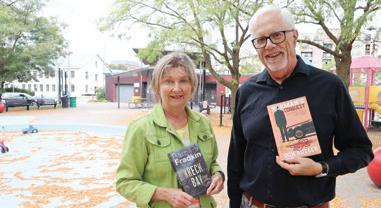

KITCHISSIPPI TIMES
Great River Media Inc PO Box 91585
Ottawa ON K1W 1K0
The Kitchissippi Times is an award-winning newspaper that has serviced Westboro, Wellington West, and surrounding communities for the last 20 years. The word Kitchissippi, meaning “great river” in Algonquin, is the former Indigenous name for the Ottawa River.
STORY IDEA? editor@kitchissippi.com twitter.com/kitchissippi
EDITOR
Charlie Senack charlie@kitchissippi.com twitter.com/charlie_senack
CONTRIBUTORS
Daria Maystruk, Simon Hopkins, Dave Allston, and Aaron Reid.
PROOFREADERS Susan Rothery
ADVERTISING SALES Eric Dupuis 613-696-9485 eric@kitchissippi.com
CREATIVE DIRECTOR
Tanya Connolly-Holmes creative@greatriver.ca
GRAPHIC DESIGNERS
Celine Paquette celine@greatriver.ca
Deborah Ekuma deborah@obj.ca
FINANCE
Cheryl Schunk, 613-696-9490 cheryl@greatriver.ca
All other enquiries 613-696-9494 info@kitchissippi.com
DISTRIBUTION
A minimum of 16,000 copies are distributed from the Ottawa River to Carling Avenue between the Britannia and Preston Street communities. Most residents in this area will receive the Kitchissippi Times directly to their door. If you would like to become a distribution point, please contact us. Copies are available at Dovercourt Recreation Centre, Hintonburg Community Centre, and dozens of other pickup locations in the area.
DISTRIBUTOR Comet 2000
info@kitchissippi.com
The Kitchissippi Times is published by

FOUNDER PUBLISHER Mark Sutcliffe Michael Curran

KT’s newsletter keeps readers up-to-date and informed SIGN UP TODAY


ENGAGE WITH NEIGHBOURS FOR TUNNEY’S ON A BIG DEVELOPMENT THAT WILL IMPACT KITCHISSIPPI:
The Wellington Village Community Association (WVCA), along with other CAs in Kitchissippi, continues to monitor progress on the redevelopment of Tunney's Pasture and push for community involvement in the process. Through our "Neighbours for Tunney's" network, the WVCA primarily pushes for clarity on how the project will protect and enhance natural spaces at Tunney's and allow for seamless and safe connections to the Ottawa River – not only for cars but for humans. We also advocate for other identified priorities: Affordable housing for families of all sizes, recreational amenities, and improved community infrastructure.
Watch your inbox for a NEW resident survey and help ensure all voices from the Kitchissippi community are included in the redevelopment of Tunney's Pasture. Join the e-list by emailing: neighboursfortunneys@ gmail.com
so bring a few toonies to participate. We look forward to seeing you at this familyfriendly community event. Watch for our flyer and your free pumpkin voucher, compliments of the Chell Team, RE/MAX Hallmark Realty Group.
Hintonburg’s super fun street hockey tournament is back for another year! Come out to play or simply watch and cheer the teams on. Winners take home the Al Norris Memorial Cup. Visit www.hintonburg.com for both registration and rules.
NOV. 2:
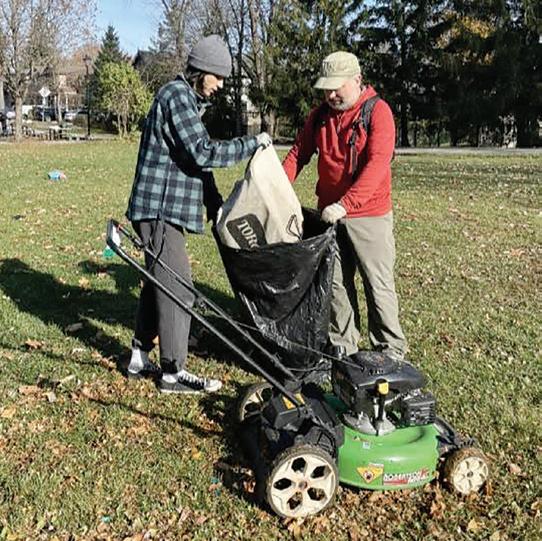
Gather all your little ghouls and goblins and join us for the 12th annual Civic Hospital Neighbourhood Association (CHNA) Pumpkins In the Park on Saturday, Oct. 19, 2024 from 12-2 p.m. at Princess Margriet Park, 265 Fairmont Ave. Rain date is Oct. 20. This fun-filled event includes bouncy castles, face painting, pumpkin decorating, music, a gift-basket raffle, and edible treats for the whole family to enjoy! Funds raised from the raffle will support CHNA and the Parkdale Food Centre,
FALL PROGRAMS ARE UNDERWAY
It’s not too late. Sign up for fitness, arts, sports and more for your best fall ever!
FALL 2 SWIM LESSONS ON SALE TUESDAY OCTOBER 15th
Group, small group, and private lessons will be available for registration at 8:00AM on October 15th at www.dovercourt.org. Check our website on October 8 to view all the classes. The session runs Nov. 4 – Dec. 22.
SPECIALTY & AQUAFITNESS CLASSES
Commit to your health with a registered fitness class. There’s so much to choose from including Yoga, strength, Pilates, spin, pre and postnatal, TRX, barre, Aqua Zumba, Water Walking and more!
FREE WITH FIT PASS
Enjoy exclusive access to 40+ weekly group fit, spin and aquafit classes, the Fitness Centre, pickleball and even access to drop-in swims with your monthly Fit Pass.
PD DAYS
Clare Gardens Park is looking its best! To keep it that way we need your help on Nov. 2 from 10 a.m. until noon to rake and mow leaves, then place them on our garden beds, weed invasive plants and pick up garbage. We’ll supply rubber gloves. Please bring a broom, a rake and/or a shovel, and a few yard waste bags if possible. This popular event is organized by the Volunteer Gardeners of Clare Gardens Park and the Westboro Community Association. Rain date is Nov. 3.
30:
Mark your calendars for Hintonburg’s upcoming craft fair happening at the Hintonburg Community Centre from 10am4pm on November 30. In addition to 50+ local crafters, there is also a bake sale, hot chili lunch, silent auction and raffle prizes, plus lots of familiar faces and good cheer. Get it on your calendar and come on out!

PD day camp programs offer a full day of activities with caring, energetic leaders. Book now for Oct. 11, Nov. 8, 25, 29 and Dec. 2. See our PD Day webpage for details.
THANKSGIVING SCHEDULE - OCT.12 - 14
See our website for details.
HOLIDAY CAMP REGISTRATION
Opens Tue. Oct. 8 at 8am
HALLOWEEN EVENT
Join us for a fun Halloween event for ages 5-12 on Sat. Oct. 26, 6-9:30pm. Check our website for details! And the Costume Exchange is back! More details to follow.



BY CHARLIE SENACK
When Italian immigrants first settled in Ottawa, it wasn’t actually on Preston Street.
the city comes from the ByWard Market neighbourhood, where newcomers lived next door to many Jewish, Irish and French families. They attended church at a small chapel on Murray Street, and moved to Rochesterville when St. Anthony’s Church opened there in 1913.
as Little Italy — has been a hub for Italians. The area was founded as and remains the traffic canal of the first western suburban settlements of the 1895 amalgamated City of Ottawa.


are preserved in the Italian Canadian Historical Centre which is connected to Villa Marconi on Baseline Rd. The facility was created in 2013 after the Canadian government apologized for the internment of Italians during the Second World War. About $16 million was offered to make changes to the curriculum and preserve the community's heritage.

“Someone created a statue, one wrote a book. What the Ottawa chapter did at that time was apply for funding from the federal government to build a historical centre to record the history of how the Italian community in Ottawa was affected and to merge that with the history of the community,” said Italian Congress of Ottawa president Trina Costantini-Powell. “They received $250,000 from the federal government. [Former Ottawa-West Nepean MPP] Bob Chiarelli lobbied the provincial government and they matched it through the Trillium Foundation and the city kicked
it into an educational facility where students could do research after school, but that never got off the ground.
In addition to being an events and information space, the historical centre also houses pieces from Preston Street's past. One of the most notable items is a cash register from 1912.
“It was the cash register from the Guzzo and Adam’s grocery store on the corner of Preston and Aberdeen where Giovanni’s Restaurant is now. This grocery store was the first on Preston, and it was there from 1912 until 1977,” said Costantini-Powell. “It was run by a mother and father, and
then their two children helped run it even though they had day jobs.”
On display next to it is a harp that belonged to the Rocco Graziadei Trio, three musically inclined brothers from Lowertown.
“He had a business where people could go and get a ticket if they were taking a ship back to the old country. If they were needing official documents, the business did that as well,” said Costantini-Powell. “When there were social functions being held on Parliament Hill, Rideau Hall, or anywhere in the community, they would play beautiful music.”
The harp dates back to the mid-1880s and was made in Paris, France. Rocco Antonio Graziadei died in 1935 after a long illness. He passed away at his home on St. Andrew Street. His family kept the instrument in their possession until his grandson's wife donated it to the centre.
In the back of the building is a mandolin, an instrument that was regularly played in
older Italian movies. It belonged to Tullio Locatelli who was a shoemaker on Preston. He eventually obtained a contract with National Defence and maintained the boots of soldiers during the Second World War.
Perhaps one of the more peculiar artifacts on display is a water fountain that sat at LeBreton Flats on the day Pope John Paul ll came to town. He arrived mid-afternoon at Uplands Airport on Sept. 19, 1984, and was then whisked away by special limousine to Dow’s Lake where he took a boat down the Rideau Canal. Over 200,000 lined the route to catch a glimpse of the Bishop of Rome.
After a jam-packed schedule, the pope was brought to LeBreton Flats where he performed an open-air mass. There were over 250,000 people in the fields, some who camped out the night before. CostantiniPowell was one of them and recalls it being a hot day. The water fountain was donated by a man whose plumbing company was contracted to set up the event.

OCTOBER 9 • 5 PM - 9 PM 366 Parkdale Avenue
Experience autumn’s bounty at the final night market of the year! Join us for an evening of live entertainment, screenings of the centennial short film, a pie recipe contest, and all the Fall fun you can handle! This event marks the end of the season, but it also commemorates a century of harvests at the Parkdale Public Market.




building a new recreation centre on Queensview Drive where an OC Transpo bus depot currently stands, but that would be years away.
“It’s a very large piece of land. When we start the light rail train service out to this area, we won’t need as many locations to service buses,” the bay ward councillor said. “This would be an ideal spot for a recreation complex and it could be a great place to have a double pad.”
But that is time local hockey leagues don’t have.
BY CHARLIE SENACK

For almost 45 years, a spaceshiplooking dome near Britannia Beach has been a community staple for skaters and hockey players who are looking for some casual time on the ice.
Now reaching the end of its lifecycle, the single pad Belltown Arena will need to be converted into a seasonal rink only open for about three months during the winter. Even then it will be weather dependent.
The city said the change is needed due to an aging refrigeration system that needs replacing along with mechanical,
plumbing and electrical issues. It would cost at least $3.2 million to continue operating in its current form, money the city says isn’t justifiable.
Alex Cullen, a former city councillor for the area and member of the Belltown Community Association, said it will be a big loss to the community.
“It was well used with a 76 per cent utilization rate — just a bit above the city average,” Cullen told KT. “The hockey rinks liked it for practice. What happens if the pipes break at the Tom Brown arena or elsewhere?”
Cullen said it appears the city has no
plan and criticized Ottawa Mayor Mark Sutcliffe who campaigned on keeping taxes low without cutting services.
“Here is our first cut. Leagues now need to go elsewhere. That will put pressure on the system. What we need is [for the] city to start putting money aside for the eventual replacement of these facilities. Closing our eyes to aging facilities is not good.”
Bay ward city councillor Theresa Kavanagh, who is also Cullen’s wife, said the news is a big disappointment and questions how oversight led to this issue not being noticed sooner.
Kavanagh said there are talks of perhaps
Ben Lee from the West End Hockey League said they use the Belltown Arena for drills and four-on-four practice games. They practice and play only once a week respectively, but use single rink pads for more time on the ice.
Having the Britannia arena only open for a few months a year won’t be useful to the players, and will create further issues at a time when ice time is already hard to come by, said Lee.
“You’ve also got ringette, girls hockey, figure skating, and all the other city-run skating programs. It’s great. We want people on ice. It’s a national favourite pastime. But Ottawa hasn’t seen any new arenas in a long time,” he said. “In the core, all the arenas are old. We are seeing significant investments in areas in the suburbs like Kanata, Barrhaven, and Orléans. There is no plan for one in the Ottawa core.”
The league is already looking for other portions which will result in more time and money for the players. Renting the ice at Belltown cost about $200 an hour, said Lee, compared to $300-$400 for the rinks at Carleton University or the Bell Sensplex in Kanata.
It was well used with a 76 per cent utilization rate — just a bit above the city average. The hockey rinks liked it for practice. What happens if the pipes break at the Tom Brown arena or elsewhere? — ALEX CULLEN


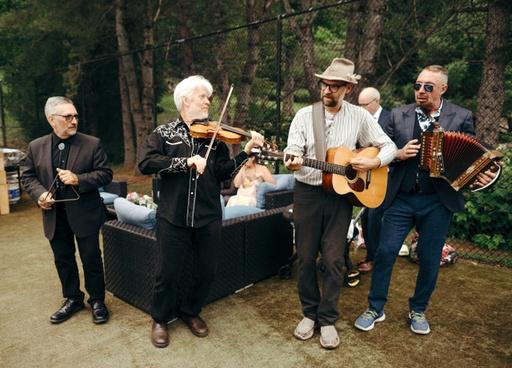











If you are newly retired or have time on your hands, the Friends of the Central Experimental Farm are urgently seeking a volunteer Treasurer. As a member of the Board of Directors, the Treasurer is responsible for and advises the Board on financial and budgetary matters. This position also involves accounting responsibilities for our day-to-day operations, supported by a volunteer bookkeeper.
Experience/knowledge in managing the financial affairs of a business or not-for-profit charitable organization. Accounting experience, preferably with a knowledge of QuickBooks. Professional designation desired.
For further information or to submit your resume, please contact




















The weather did not disappoint for the annual Taste of Wellington Event on Sept. 21.
More than 50 Hintonburg and Wellington Village restaurants and shops offered free food samples, discounts, sales and entertainment — all in an effort to showcase what the rich neighbourhood has to offer. KT photographer Aaron Reid joined the thousands of visitors who enjoyed the day.
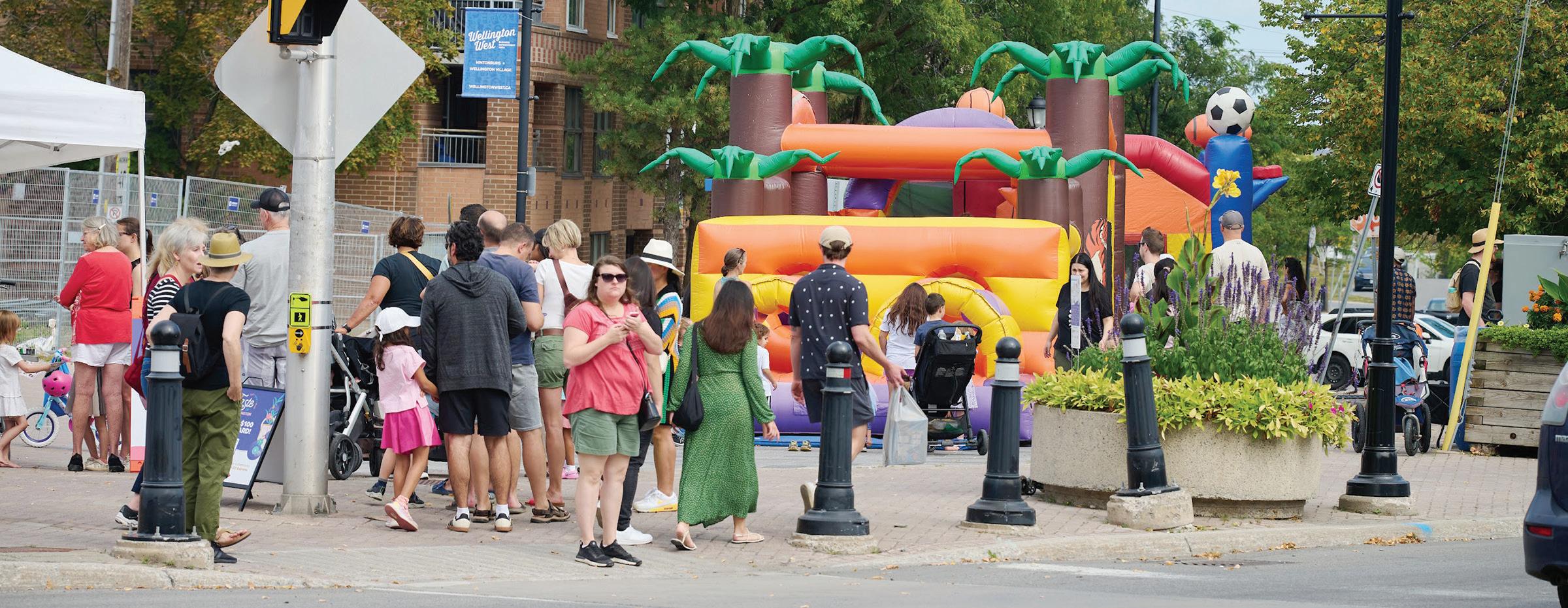







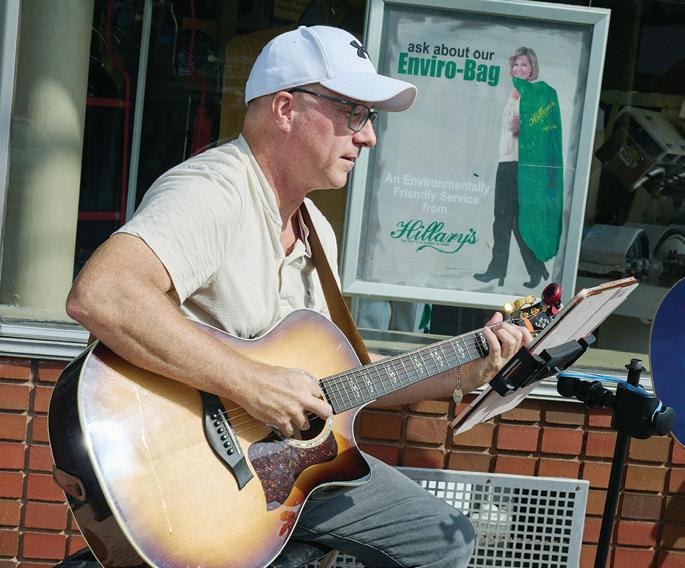









Comfortable, affordable, retirement living in the heart of Kitchissippi. Unitarian House is the only not-for-profit Retirement Home in Ottawa. Included in the cost are assistance with medication, 24-hour Nursing Care, assistance with bathing, meals, snacks, activities, laundry, and housekeeping.

Book a personal tour of our Retirement Residence today by calling 613 722 6690 Ext. 234 or by visiting www.unitarianhouse.ca.
Please call us, email retire@unitarianhouse.ca or visit our 40th-anniversary page at www.unitarianhouse.ca/40th-anniversary for more information about our special events.



BY DARIA MAYSTRUK
Local seniors and youth are painting a mural at Viscount Alexander Public School as a call for climate action, only six months after the launch of the advocacy group Seniors for Climate.
The mural, set to be painted sometime in early October, also marks the first
National Seniors for Climate Day. The day was proposed by Seniors for Climate to highlight seniors’ desires to rebuild a healthier environment for future generations, according to the Seniors for Climate website.
Letitia Charbonneau, convener for the Seniors for Climate Action Now group in Ottawa, said the idea for the mural came to her after she ran into her friend, local artist
Claudia Salguero, at a party.
“I saw Claudia across the room at the party, and this light bulb went off in my head. I went and I grabbed her, dragged her outside the party, and proposed that idea to her,” Charbonneau said.
Charbonneau said Salguero “didn't even think twice,” despite a lack of funding.
Salguero is no stranger to painting murals
According to Natural Resources Canada, the country is warming at twice the global rate — about three times the global rate in the Arctic. There are concerns that sea-ice deterioration and changes in permafrost are expected to put communities and infrastructure in the North at risk.

The Climate Atlas of Canada says weather records from across Canada show that every year since
1998 has been warmer than the 20th century average.
The year 2023 was a historic one for forest fires in Canada. Over 230,000 people were evacuated because of potential dangers to life and health. A total of 6,623 wildland fires burned more than 15 million hectares of Canada’s managed forests. Smoke from the fires reached many North American cities, creating a haze which

brought poor air quality. Over the next 50 to 100 years, atmospheric concentrations of carbon dioxide are expected to double or triple. That will lead to global temperature increases of between 1.5 and 5.9 degrees Celsius over a very short period of time. In comparison, earlier global temperature changes took place over a period of 5,000 to 20,000 years.


in Ottawa. Her past works have appeared on the side of buildings and in schools such as Red Apron on Gladstone Avenue and Cambridge Street Community Public School.
She says painting murals is a way to bring communities and generations together.
“One of the things that I also believe in big time is that we need to bring wisdom to the new generations … And art is a big tool for this,” Salguero said. “When Letitia told me what this mural was about, I got very excited.”
Now both on-board, Charbonneau applied for an Awesome Ottawa award, which she received in August. The $1,000 award is supplied by ten trustees and given out monthly to support projects in the community and abroad, according to the Awesome Ottawa website.
The effects of climate change have been felt in Ottawa with many rare storms which have hit the Capital. They include tornadoes in 2018 and 2023, and a derecho in 2022. The historic Rideau Canal has also seen the effects of a warming planet. For the first time ever, it did not open in 2023 due to a lack of ice thickness. Still, the National Capital Commission spent over $1 million for upkeep. This year the canal was only open for 10 days, the shortest opening season on record.
Awesome Ottawa trustee Avi Caplan said Charbonneau and her group stood out to the organization for its engagement of the community in designing and producing the mural.
“Activities like this that leave behind something tangible are a great reminder that ordinary people can just roll up their sleeves and make things happen that they want to see in the world — something that we think is really awesome,” Caplan wrote in an email.
Charbonneau said she also hopes the mural creates a “dialogue between seniors and youth working together to bring hope.”
“It's not to create anxiety about climate change, it’s the opposite,” she said. “It's more to help students realize that they have a voice and how to use it, that what their ideas are are valid, and to give them a sense of their own agency.”
With a flash mob and conference also on the docket for Seniors for Climate Day, Charbonneau said the group will continue to fight for climate action.

Above: Letitia Charbonneau and Claudia Salguero received an Awesome Ottawa award for their project idea. Photo provided by Awesome Ottawa. Insert: Claudia Salguero painted the Wisdom Mural at 1365 Bank St. in collaboration with Indigenous elders and knowledge-keepers.
PHOTO PROVIDED BY SALGUERO.
“Seniors have nothing to lose. We're mostly retired. We have children, we have grandchildren, we have youth in our lives, and we're very concerned. We're very worried about what can happen in the future. And we want our legacy to be that we did everything that we could to make sure that the following generations have the sustainable, healthy, pleasant future that they deserve,“ she said. “This is just the beginning.”










Self-care is in the air! Please join us at Westboro Park, a senior lifestyles residence, for a community event inspiring a healthy lifestyle. Listen to medical expert presentations, receive complimentary health screenings, and watch innovative product demonstrations.
You’ll learn insights and tips about many topics, including fitness, nutrition, cholesterol, blood pressure, vision, hearing and more.
Thursday, October 17 11:00 AM – 3:00 PM
PLEASE RSVP TO ALLEY OR NAHA AT 613-728-9274.
We look forward to seeing you!



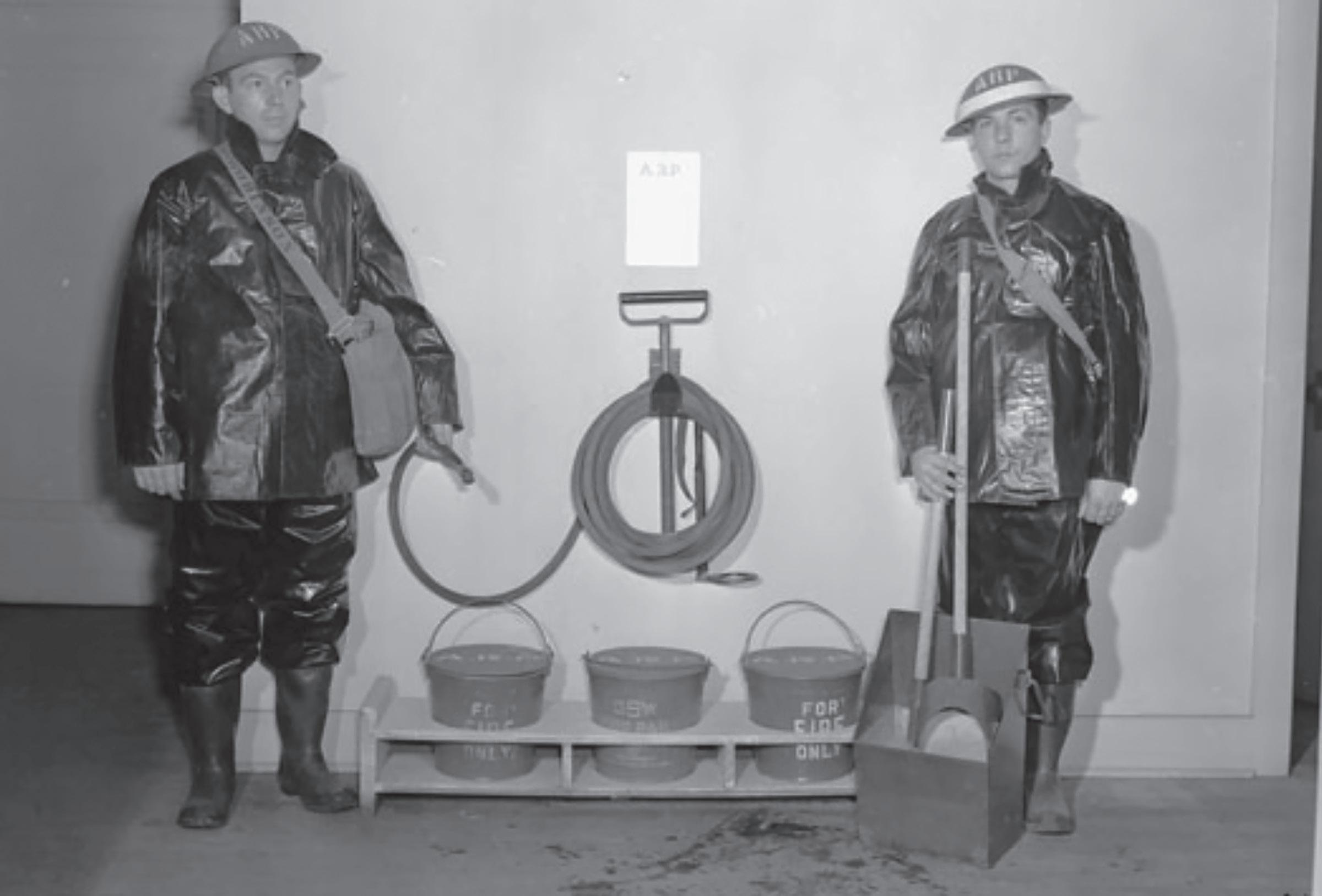
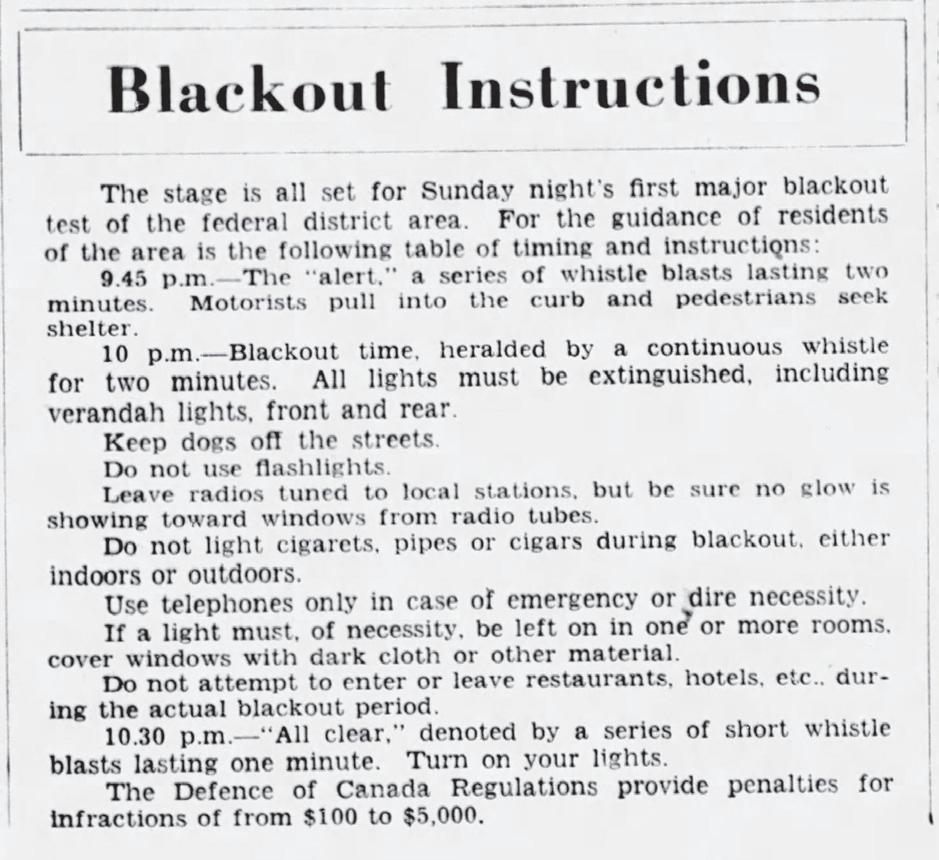
1. Royal Canadian Navy personnel with ARP equipment Halifax on Nov. 4, 1942.
CREDIT: LAC PA-105977
2. An Ottawa Citizen clipping from Nov. 21, 1945 advertising Blackout instructions.
3. An Ottawa Citizen clipping from March 21, 1942 promoting air raid precaution demonstrations.
BY DAVE ALLSTON
It is hard to imagine that there was once a time when the residents of Kitchissippi genuinely feared an attack by air.

The year 1942 brought great anxiety throughout the world. As the Second World War raged in Europe, North Africa, and Asia, the threat of an attack in Canada grew. Coastal regions — and its government nexus in Ottawa — were seen as likely targets. Munitions plants, dockyards, wharves, railway yards and factories were all high-profile potential bombing threats.
In fact, even well before Pearl Harbour saw the war come to North American soil, the Canadian government had established an air raid response program, so that it would be prepared if it needed to suddenly implement a widespread plan.
This became a highly political topic in Canada. Though civil defense was
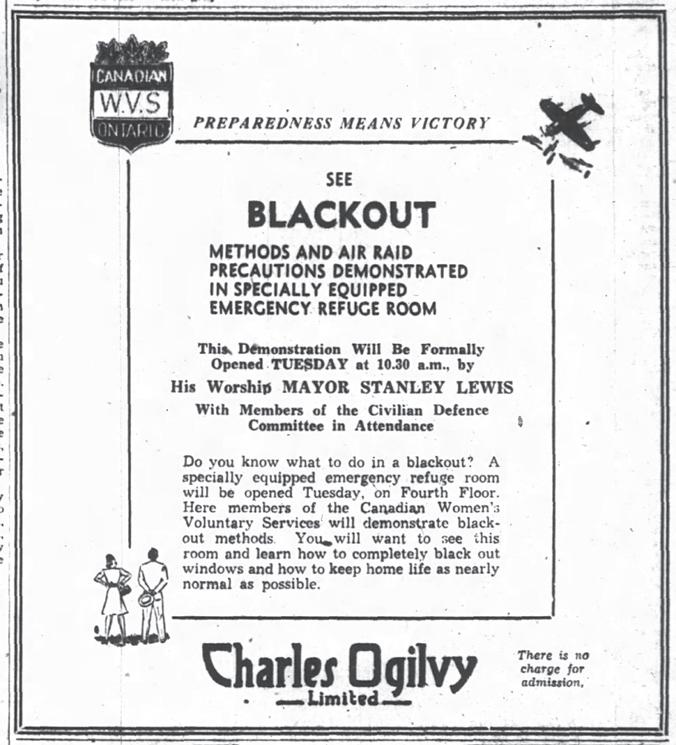
clearly a federal responsibility, the implementation would have financial and practical responsibilities to be sorted with the provinces. These political decisions would drag on through the early part of the war, and a lack of a cohesive plan meant municipalities were often on their own to
solve issues that needed to be dealt with federally.
Much debate was even held as to which department would be responsible for the oversight of Canada’s A.R.P. (Air Raid Precautions) program. It would not be the Defence Department which oversaw this coordination, but rather the Pensions and National Health Department, as it was seen that the effects of the attacks, particularly if gas was used, would be health related.
By 1941, the City of Ottawa was still in a scramble for a master plan. Ontario had initially refused to participate in the federal A.R.P. program, but relented in the fall of 1940. A dedicated division was soon created for the National Capital Region, with first-aid posts set up, and 2,000 wardens recruited to oversee. But the division of responsibility was often unclear.
At the top of the agenda for city officials in Ottawa were roles which could be delegated to residents: blackouts, rapid bomb
extinguishing, and construction of air raid shelters.
Once WWII began, in England, shelters were becoming increasingly necessary as Nazi Germany had been bombing London and other strategic points across Britain throughout the fall of 1940 into the spring of 1941. Though high-income earners would pay for their own shelters, the government subsidized citizens within lower income brackets to build a shelter within their home, while also paying for the construction of those in larger public buildings. In Canada, no formal plan was instituted.
Ottawa held its first blackout test on Oct. 26, 1941. The federal government had installed air raid sirens in just seven locations in Canada — including one in Ottawa — which was installed on the roof of No. 2 Hydro Sub-station at the corner of Carling and Bronson.
At 9:45 p.m. on that date, the air raid warning was sounded from 47 points in
Ottawa-Hull, using the siren, railroad engine whistles, factory whistles, radio broadcast of recorded siren sounds, and other methods. Then the official “action warning” siren droned at exactly 10:00.
“The wave of screaming screeching sirens blew like a gale over the city,” reported the Citizen as the blackout began. Homes and any open restaurants or businesses were required to turn off their lights and lock their doors; automobiles and street cars were halted and lights turned off; and everyone was to remain inside until the “all clear” was sounded.
The test seemed to go well, except for an error made by the Ottawa Light Heat and Power Co. They failed to turn off the “whiteway lights” on Wellington from Elgin to Bank, “illuminating the buildings for the benefit of the theoretical enemy,” noted the Journal. These strong lights remained on for half the blackout, as an employee had misunderstood and turned off only a bank of lights in Westboro.
By 1942, the threat of an attack was heightened. The city was concerned about aircraft flyovers dropping incendiary bombs on houses and businesses. Ottawa put extra emphasis on first ensuring that water services and fire protection were maintained in a constant state of readiness.
Ottawa Fire Chief J.J. O’Kelly launched a major campaign to educate citizens on how to fight incendiary bombs and the resulting fires. A system was put in place of having two to four “wardens” on each city block — plus larger teams representing commercial businesses — to work with the fire department. Wardens were trained on providing lectures in the methods of dealing with bombs and fires, and travelled to every home in their designated area to provide these instructions. These volunteers wore A.R.P. armbands as identification and many also wore a combat (Mark II) helmet.
The instructions stated that in the case of a bomb raid, “each householder must be his own fire fighter. The fire department will be too busy on large fires to fight one in your house, and your insurance will not protect you in case of loss.” It also noted that bombs “will likely penetrate the roof and lodge in the attic”, and thus this was where it was most likely they would have to be dealt with.
Attics were to be cleared of all inflammable material, and two or three 10-pound paper bags of sand were
requested to be kept in the space along with a shovel and a hoe. Citizens were told not to use fire extinguishers or a jet of water to extinguish the bomb, as it could cause greater damage.
“If you can reach the burning incendiary bomb within a minute or so, you can easily extinguish it,” stated the fire department. “If you take five minutes you will be too late… Act very quickly and do not be afraid. Plenty of women in Britain have successfully fought incendiaries.”
Sand was seen as the best solution to fight these potential bombs and fires. The City acquired huge amounts of sand and distributed it throughout the city to various hubs, mostly schoolyards, for pickup in April 1942. The main distribution point for Kitchissippi was on what is now Harmer, near Byron Avenue.
City council was discouraged when very few citizens took the warnings seriously, and the sand remained largely unclaimed. An editorial in the Citizen surmised that Ottawans suffered from apathy and laziness, with residents used to having services delivered direct to their doorstep. ”A good number of us think it is a great imposition to fetch a few pails of sand a few blocks,” it wrote, though it also added that likely many Ottawans simply felt that if the city were ever bombed, a few little pails of sand wouldn’t make much of a difference.








To solve the issue, the Junior Board of Trade oversaw the distribution of buckets of sand to every individual house in Ottawa and Westboro, courtesy of local high school boys who were paid in soft drinks for their hard work.
Deputy Chief Engineer of the British Ministry of Home Security, Professor Frederick Webster, visited Ottawa in February of 1942 to advise on how Canada could implement air raid shelters and camouflage for industrial buildings.
The first air raid shelter built in Ottawa was actually constructed in Kitchissippi. It was privately built as part of a new house on Parkdale Avenue near Ruskin in the late summer of 1942. The shelter consisted of a large room 12 feet by 20 feet, built underneath the garage, and connected to the house by a nine-foot long tunnel, which was 5’ high and 5’ wide. The tunnel and the floor of the garage acted as the roof of the shelter, which was built of concrete.
By 1943, the threat of air attacks had all but disappeared, and the Air Raid Precautions groups were disbanded.
Friday October 18 (7pm-9pm) and Saturday October 19 (9am to noon)
630 Island Park Drive, Ottawa K1Y0B7
Books, kitchenware, linens, household items, toys, small appliances, jewellery, bake table and more!




BY CHARLIE SENACK
It’s a sunny warm September afternoon at the Dominion Arboretum and joggers are out catching some rays before the eventual return of cooler Canadian temperatures. On the nearby canal, kayakers bask in the breathtaking blue water. A stork watches from the shoreline. Geese fly overhead and squirrels climb up nearby trees.
What beauty nature marvels.
This urban oasis in a city of over a million people officially began in 1889 as part of the Central Experimental Farm. Its objective was to do a lot more than be a park. Most of the 175,000 people who enjoy the public green space yearly have no clue of the important work it actually does.

The 64-acre Arboretum is home to 4,000 different kinds of trees and shrubs from 56 different species, many you wouldn’t be able to find elsewhere in Ottawa. The whole purpose of the site is to test various plant species from elsewhere to see how they would fare in an unpredictable Ottawa climate.
“There is a desire to try something new. We are still in the North, but somewhat similar to the Niagara region, the United States and Europe,” said Robert Glendinning, who has worked as a propagator at the Arboretum for the last 20 years. “A lot of the more recent plantings are regarding hardiness which has always been a theme. It used to be about seeing if the trees can live here. Now it’s to see what still grows here and is happy.”
Climate change has impacted the Arboretum's operations. Due to changes in temperature and weather patterns, some plants which used to thrive here no longer are. Others, meanwhile, are starting to grow and climatize.
When new trees are planted, they require more maintenance to settle due to the extreme heat. Storms have also played a factor. Luckily, the Arboretum has mostly been spared from the tornadoes, microbursts and El Niños which hit the Capital, but some century-old trees were lost.
On average, about 100 trees are lost at the Arboretum per year. The lifespan of trees can vary from about 30 years to over
a 100. A few trees near the nature preserve’s lookout are from the late 1800s.
also found that proximity to the farm was associated with lower levels of fine particulate matter known as PM2.5 in the winter and fall.

“It’s unfortunate when trees leave us, but generally about 150 to 200 trees are planted per year,” said Glendinning. “This year we planted flowering dogwood. It’s not supposed to grow here but it’s been doing well in the nursery. We also got some new magnolias. We get seeds from various other Arboretums and botanical gardens. Lately we have been planting new trees which are hearty in Europe like Russia and Siberia.”
The collections at the Arboretum are especially rich in such hardy groups as crab apples, junipers, lilacs, maples, spruces and pines.
According to a Carleton University study produced in 2019, it found that the Dominion Arboretum's air quality was better than in other parts of the city. The data was collected during a 14-day period during each of the four seasons in 2016.
Central Experimental Farm space was associated with lower levels of airborne particulate matter known as UFP, black carbon, and temperature in the fall. It
During the Victorian period, a great interest in natural sciences grew. What we know today as the Central Experimental Farm began in 1886 after lobbying from John Carling who was the Minister of Agriculture, and William Saunders, who was first director of the branch. It started with 188 hectares of land but is now 426 hectares in size. First plantings at the Arboretum occurred in the fall of 1889 when 200 trees and shrubs were planted for testing. A decade later, the site numbered over 3,000. The plants came from as far as Japan, Korea, France, England and parts of the United States.
According to the Government of Canada, in the early years trees and shrubs were acquired from the once-famous nurseries of Spaeth in Germany, Louis Freres in France, Ellwanger and Barry in Rochester, New York, and the Arnold Arboretum in Jamaica Plains, Massachusetts.
Today testing still occurs at the Arboretum, although it’s no longer an official research site. It used to employ about 30 people but today that number is just four. Glendinning said he hopes the site's importance will be recognized even further today at a time when so much public greenspace is being bulldozed away for development.
“When you look down at Preston [Street], I never used to see skyscrapers on the horizon. Where do those people go to enjoy the outside? Here. With intensification, people need greenspace,” he said.

BY CHARLIE SENACK
Each tree in the Dominion Arboretum has a story and a purpose.
Yet when most people walk through the vast greenspace, they don't stop to think about how the beauty they are enjoying was made. That is why the volunteer awareness group Friends of the Central Experimental Farm decided to write a new book titled Friends of the Trees
“We had a tree book in the past but we don't have one now. Many of the trees in the first book are now deceased so it was time to redo it with a slightly different approach,” said co-author Eric Jones. “We wanted to showcase why it’s such a special place with all these specimens of trees. A lot of people come here to walk
In the middle of the Dominion Arboretum is a rare tree. The Bebb’s oak, a natural hybrid of white oak and bur oak, measures 21 metres tall and has a girth of 5.75 metres.
It’s believed the big oak was collected from woodlands in the
their dog or enjoy the benefits of the green space, but don’t know the significance of all the trees.”
The Arboretum's landscape is constantly changing. Through various wind storms, trees have toppled. In 2010 the tree-killing emerald ash borer was found on the property. The invasive beetle pest that originated in eastern Asia was first discovered in Ottawa near St. Laurent Boulevard in 2008. Almost all of the tree specimens on Ash Lane had to be cut down a few years later. Some were more than 80 years old.
Arboretum, the Ornamental Gardens and other public areas of the Farm, in partnership with Agriculture and AgriFood Canada.”
Richard Hinchcliff, who has been a photographer and researcher with Friends of the Farm for 20 years, said he hopes the book will carry on the legacy of William Saunders, a Canadian agriculturalist, entomologist and pharmacist.

Friends of the Farm was formed in 1988 with the mission to “preserve, protect, maintain and enhance the Dominion
“He had this incredible vision for the beauty of how a farm could look and operate,” said Hinchcliff. “He created the Central Experimental Farm as a model for Canadian settlers.”
Saunders was regarded as the leading authority on agriculture and horticulture
in Canada. In 1885, the Canadian government asked the farmer from England to investigate the feasibility of implementing an experimental farm system similar to the model used in the United States. His recommendations were accepted and for the next 25 years, he led research into horticulture, forestry, and animal husbandry — including the creation of the Central Experimental Farm.
The book aims to introduce readers to the few 130-year-old trees which remain and the different species which have been planted since. Most of the original trees are located in what’s called the “circle area” which is near the Prince of Wales entrance.
“I hope that readers will learn a little bit about the diverse and interesting collection of trees that exist in the Arboretum,” explained Hinchcliff. “I hope they do more than just enjoy it as a beautiful recreation space. It’s important we provide some practical information on the trees of Ottawa.”
Friends of the Trees will officially be launched during an event at the farm’s Neatby Building from 3 to 5 p.m. on Oct. 6.
area and planted in the Arboretum in 1898.
In 1993. Trevor Cole, former curator of the Dominion Arboretum, wrote “it takes three men with outstretched arms to encircle the trunk. All this from an acorn, in less than 100 years.”
In recent times, the tree was named after Ardeth Wood, a Canadian graduate who was
treesarelostattheArboretumper treescanvaryfromabout30years thenaturepreserve’slookoutare GLENDINNING
killed in a forcible drowning on the Rockcliffe Parkway. The two-year search for her killer was one of the biggest manhunts in Canadian history.
During a storm on Sept. 27, 2017, about a third of the oak tree's trunk was damaged due to violent winds. At the time a fence was installed around the tree and a local arborist said it still has decades left to live.
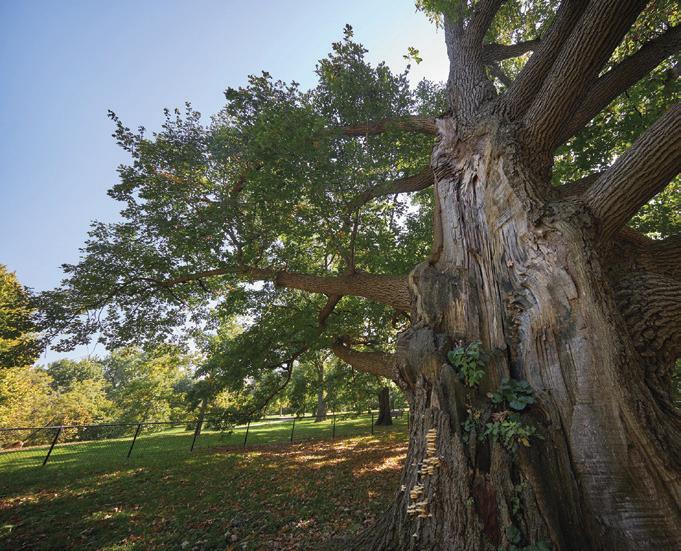
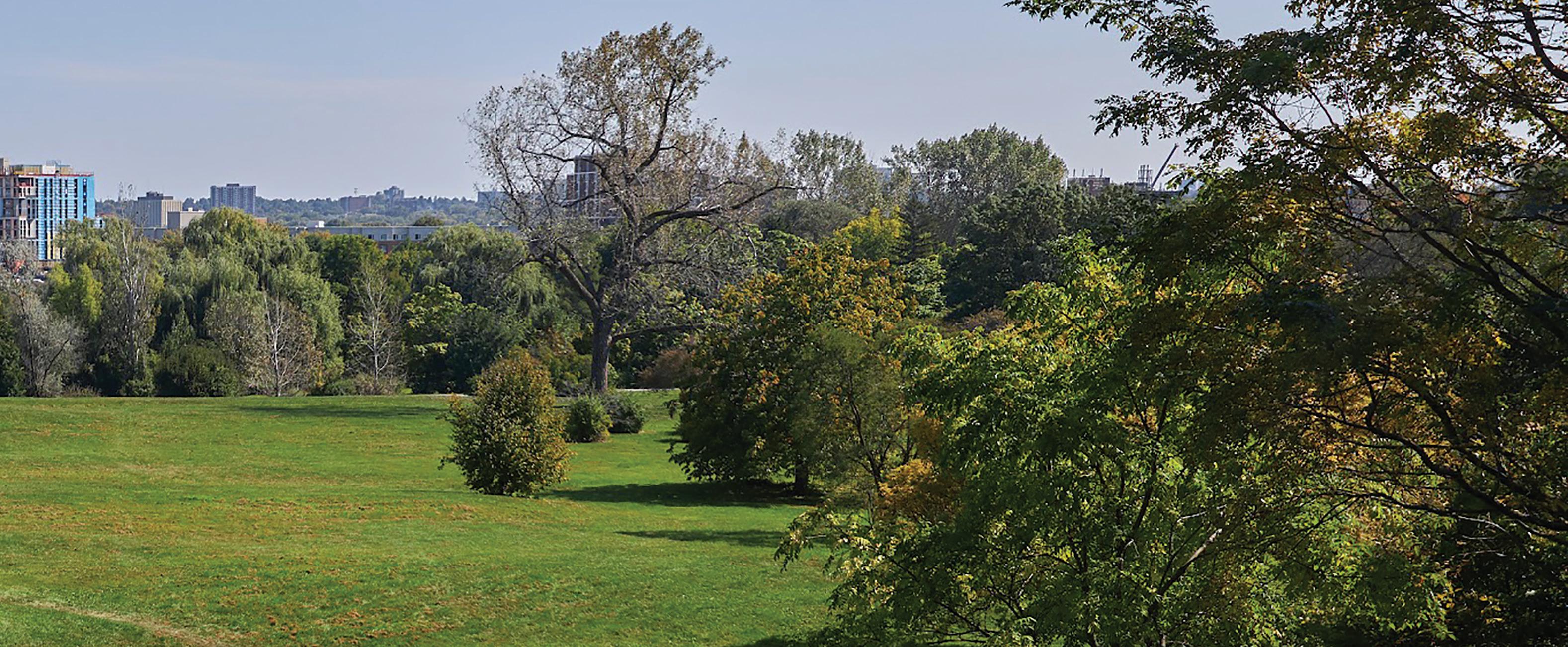




DON BUTLER
Island Park area resident Don Butler drew inspiration from his former Ottawa Citizen newsroom when he wrote his first book A Life of Bliss. The former journalist of 40 years turned author released the mystery novel in 2021 after sitting on the copy for a few years.
The book, published by Ottawa Press and Publishing, is about Bliss Browning, a timid travel editor of the fictional Ottawa Daily Advocate, who is contacted by the late opera diva Maria Callas from beyond the grave. At the urging of the ghostly presence he travels to Greece and embarks on an unusual journey which “could be the key to his own salvation.”
To build on its success, Butler released Norman’s Conquest earlier this year. Second in the series, it follows returning character Norman Pugsley, who becomes entangled in a decades-old murder mystery.
“The basic theme is redemption and trying to win in life when it seems your best days are behind you. You want to make contributions and right a wrong to solve a problem that’s been neglected,” said Butler.
“That makes it sound serious but it really isn’t. It’s an entertaining book that's focused around journalists during the heyday of newspapers. It’s a fast moving story and it moves around in time. It’s a book you can read in a day or two because you can’t put it down.”
According to the book's synopsis: “The tale unfolds against the backdrop of unlikely romance and unforgettable encounters — from a spirit bear to a former prime minister. Join Norman Pugsley's journey, where the past collides with the present, and every twist and turn brings him closer to solving the murder.”
Butler is planning to start work on a third in the series next year.




When Westboro area author Barbara Fradkin started to spell at the age of six, she began creating stories of imaginary friends going on adventures.
In adulthood, the child psychologist of 20 years started to put pen to paper and write mystery novels. Fradkin's first short story was published in 1994, and the books started flowing soon after. To date, the crime fiction writer has published over 30 stories.
The Montreal-born Fradkin is a member of the notorious Ladies Killing Circle, a group in which like minded “kindred souls” get together and “ask what an autopsy looks like, how to poison someone, and what police do when they get to a crime scene.”
Mystery authors, Fradkin admits, can have twisted minds. Most of her books are set in Ottawa, including her first Do or Die, which was primarily set at the University of Ottawa.
“There are great places to bury bodies in Ottawa. We’ve got four or five rivers and a lake in the middle of a city. There are lots of places to drown people,” said an energetic Fradkin. “There are big cliffs where you could push people over and many natural parks where you can bury people. I
buried someone at Bruce Pit as an example.”
Nobody was harmed in the making of Fradkin’s stories. The book is one of 11 in the Inspector Green series. The Ottawa-based detective used to run the criminal division but in later sequels is sent to a desk job at the courthouse after getting in trouble. He still finds ways to meddle in cases.
Shipwrecked Souls, a 12th book in the Inspector Green series, will be released in January. It has a Kitchissippi connection.
“It starts off with the murder of an old elderly woman in the back alley in the Britannia neighborhood. The victim has no ID but she has a note in her pocket with three different languages on it with short phrases. Over time, they identified her as Ukrainian who was looking for someone. Through the book I track down what happened to her.”
Fradkin’s latest novel Wreck Bay was published in January 2023, and is part of the Amanda Doucette series. In this installment, the thirty-something international aid worker pursues the connection between a reclusive artist and the wealthy surfer who turned up dead on a remote island in Vancouver Island’s Pacific Rim.


For 20 years, Kitchissippi’s Katie Tallo threw her inspiration into the television and production industry. The Carleton and Algonquin graduate wrote screenplays, worked in animation, and made motion pictures.
But in the back of her head was always the thought of one day being an author. Inspiration for putting pen to paper came after reading Stephen King’s book on writing.
“In it he says to take a few characters, throw them into a situation, and see where they are going to go,” she said.
Tallo tried it and success followed. She won an international novel contest out of the United Kingdom for women writers in 2013, and landed a publishing deal for her first novel, Dark August in 2021. The murder mystery is set in Wellington West where she lives, and follows Augusta (Gus) Monet, who becomes an amateur detective after finding her late mothers cold case files in her grandmother's basement.
“Gus’ mother, who was a police detective, died when she was eight. She starts building her moms evidence wall from memory, starts investigating the case, and finds out why she really died,” stated Tallo.
The novel became an international bestseller and was chosen as an Apple Book of the Month and New York Times Editor’s Choice. It led to a second in the
series, Poison Lilies, which is set after Gus solved her mothers murder. After digging into her past, the mystery solver moves to an apartment in the Glebe where Gus befriends the elderly Poppy Honeywell. Things take a turn when a body shows up in a nearby pond.
All of Tallo’s books are set in Ottawa and include references to real places and businesses. In Poison Lillies, a made-up character named Howard is ironically a freelance journalist at the Kitchissippi Times. Howard makes another appearance in Buried Road, Tallo’s third and final book in the series, which will be released on Dec. 3. It is narrated by Gus’ 13-year-old daughter Bly.
“It jumps ahead 13 years into the future,” said Tallo. “I love to explore memory and how that feels and impacts a character. This is about a young girl who takes a dangerous road trip to look for a missing person in Prince Edward county.”
While it will be a final installment in the series, Tallo has already penned another novel about a “70-year-old spitfire” who takes on Ottawa’s criminal underground.
“I’m not sure if it will become a series. It wraps up and I don't know if I need to keep going with her,” said Tallo. “But I have other books in my mind already and other genres. I have somewhat of an apocalyptic story in my brain that I can’t get out.”





BY DARIA MAYSTRUK
Peter Joynt still remembers using skateboards to push a quarter-pipe down Island Park Drive with his childhood friend Alan Gustafson and brother David Joynt. Though much has changed in the more than 30 years since that day, Joynt still lives nearby with his family. Joynt, whose stage name is The Joynt, showcases his love for the neighbourhood in his newest music video “Island Park Drive.”
The song draws on the fondness of his childhood memories around Island Park Drive, including the day with the quarterpipe, and takes a relaxed perspective on the now-traffic-heavy street.
“It's such a great street, and yet it's so hard to take the street because of the traffic … Back when we moved the ramp, it was like the odd car out for a cruise, not quite the bumper-to-bumper traffic you see these days,” he said. “I've always been fascinated by it because of that, and because it's got this tropical, kind of exotic sound to it. ‘Island Park Drive’ sounds ritzy and as though it should be in the

Caribbean or something, as though it's some coastal drive.”
Joynt wrote, performed and produced both the song and the music video mostly himself, with some help along the way.
He said his friend Gustafson indirectly served as visual inspiration for the music video. The 1989 Volvo wagon featured in the video belonged to Gustafson, who passed away in 2016 from ALS.
“I thought of renting a classic car, but then that kind of wasn't quite the right vibe,” Joynt said. “Driving [the Volvo] feels like you're driving a big couch — it's this


big, slow kind of ride, and I thought that would be perfect for the shoot … Alan lived just off Island Park Drive, and so it all kind of fit.”
As well as working at Shopify and being a rapper, Joynt is also a public speaker for schools around Ottawa. His talks focus on his resiliency and self-acceptance surrounding his speech impediment, which he says is caused by his brain producing speech from its right side, rather than its left like others do.
He says the criss-crossing of his right and left brain that causes him to stutter also allows him to find the creative process perhaps easier than others do. In fact, when he starts rapping, the stutter disappears.
Spreading his story is his way of spreading inspiration to the next generation.
“Just because you have a thing — if it's a stutter or a food allergy, or you look different or sound different — don't let that hold you back. You can still go on and do great things in your life,” he said. “If you put good vibes out there in the world, you get good things back.”
If there’s one key takeaway of “Island Park Drive”, Joynt says he wants people “to go slow and enjoy the ride” — something he says he has learned as he’s grown older.
“That's what you have to think about every time you get on to Island Park Drive: it's going to take some time, so don't be trying to ram up someone's tail or follow too close. Chill out. Roll the windows down. Take your time. Enjoy the ride,” he said.
“When you're a kid, you can't wait to get old … but when you're old, you want to slow it down and go back to being a kid.”


Want to eat better and support local farms and producers?
Choose us and we’ll deliver freshness to your door, year-round!
Subscribe today for next week’s deliveries: shop.alimentsfarmhousefood.com
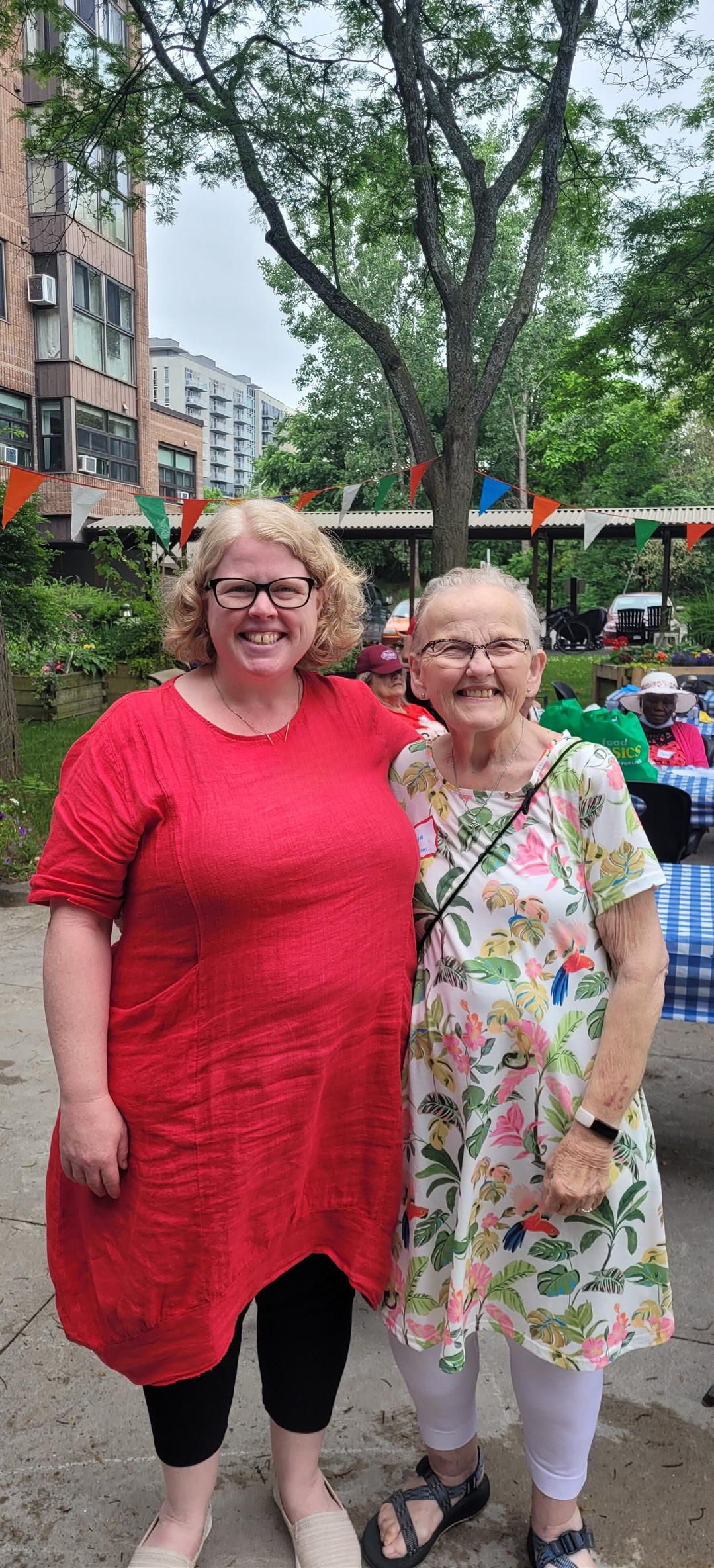
Each year, community support services assist over one million seniors and people with disabilities by providing services to help them age at home and in our community. In October, we celebrate to raise awareness about the value of these services and thank the staff and volunteers who make them possible!
October 9: Congregate Dining Day (Luncheon Program)
October 11: Assisted Living Services Day
October 14-18: Community Care Worker Week
October 15: Telephone Reassurance Day
October 16: Respite Services Day
October 17: Falls Prevention and Exercise Day
October 18: Crisis Intervention and Assistance Day
October 21 - 26: Adult Day Program Week
October 25: Home Help/Maintenance/Homemaking Services Day
October 28: Transportation Services Day




BY CHARLIE SENACK
Anew music festival in Ottawa is looking to introduce arts lovers to Canadian-made classical music while also tackling the city’s homeless crisis.
On Oct. 17 and 18, the Ottawa New Music Festival will be launched by the Ottawa New Music Creators at the Ottawa Art Gallery. While the organization has been around for 12 years, this is the first time they are producing a festival of their own.
“In the past we have produced concerts scattered throughout the year and we thought it would be entertaining to focus on one weekend where we could draw a bigger crowd and have people in Ottawa get excited about contemporary music,” said organizer Zac Pulak.
“Pretty much every single major city in Canada whether it’s Toronto, Montreal, Vancouver, or even Saskatoon, have new music festivals, yet Ottawa has none that are focused on contemporary music.”
Leading the show will be the world premiere of Frank Horvat’s “Almost
Homeless - Ottawa”, which examines the realities faced by a growing number of people who are grappling with financial hardships and the high cost of living.
Horvat, who lives in Toronto but grew up in Westboro, said the composite is one he’s been thinking of for many years.
“I started reading reports about how many high level musicians were leaving and moving out of the city because the cost of living was becoming so drastic,” Horvat told KT. “I found it so fascinating since Toronto promotes itself as an arts and culture hub. It’s a cruel irony that the
• Annual Biology Butterfly Show, Oct. 5-13: The Annual Butterfly Biology Show looks forward to welcoming you to the annual free Biology Butterfly Show. Reservations are required. At Nesbitt Biology Building, Carleton University, 1125 Colonel By Dr.

• Watson’s Mill Harvest Festival, Oct. 13: Come to Watson's Mill for their annual Harvest Festival! There are a bunch of activities and crafts. It's sure to be fun for the whole family. At Watson’s Mill, 5525 Dickinson St. in Manotick.
• Enriched Bread Artists Annual Open Studio, Oct. 17: Enriched Bread Artists are opening their doors to you. EBA continues to bring you contemporary art activity through its annual Open Studio. Their artists also exhibit to local, national and international audiences
throughout the year. You can visit 21 active artists engaged in critical research and on-going artistic explorations in their studios housed over two floors. At Enriched Bread Artists, 951 Gladstone Ave.
• Signatures Handmade Market, Oct. 17-20: Shop at a uniquely Canadian handmade indoor marketplace that features the works of independent artists, artisans, makers, and designers. At Aberdeen Pavilion at Lansdowne, 1000 Exhibition Way.
• Halloween Howl Market, Oct. 26: Enter the Halloween Howl Market where the spooktacular entry is free, bewitching door prizes await and local vendors conjure up a cauldron of delights. Embrace the hauntingly festive spirit with your canine companions, as dogs are welcome and treat
arts workers can’t afford to live here. The vision of it was to use a composition to highlight the state of how it impacts the music community, but it also doesn’t take much time to realize that everybody from all walks of life are struggling to make ends meet.”
The Westboro-born composer, who started taking music lessons at five years old, said he tries to compose songs that address the current state of society. Oct.17 is also the International Day for the Eradication of Poverty, and hopes his music will eventually be played world-wide on that day to inspire all walks of love.
Back in June, Horvat took a trip to Ottawa’s Arts Market on Daly Avenue where the New Music Creators set up a booth to speak with young people who have been impacted by the cost of living crisis. Their voices will echo through the music during the Oct. 18 performance.
“Individuals were very gracious and were able to share their struggles, hopes and dreams for the future. It was a really moving thing for me because on a personal front, having grown up in Ottawa, it’s a side of the city I don’t know,” said Horvat.
them to on-site paw-dicures for a ghoulishly delightful familyfriendly experience! At Shenkman Arts Centre, 245 Centrum Blvd.
• The Ottawa Chocolate Show, Oct. 26: Meet award-winning chocolate makers, chat, sample their chocolate and take home a few bars! Sit in on presentations, workshops and pairings to delve further into the delectable world of chocolate. At Algonquin College, 1385 Woodroffe Ave.
• Pumpkin Fest, until Oct. 27: Pack a lunch and bring the whole family down to the Annual Pumpkin Festival featuring a petting zoo, corn maze, wagon rides, pickyour-own pumpkin, and loads of fun on multiple outdoor playgrounds! At Proulx Maple & Berry Farm, 1865 O'Toole Rd.
"Almost Homeless” features ONMC Artistic Directors SHHH!! Ensemble and Ottawa-based violinist Erica Miller. The second half of the concert will include SHHH!! performing works by Harry Stafylakis, Jocelyn Morlock, and Micheline Roi.
Then on Oct. 18, an epic triple header will bring together Halifax-based cellist, composer, and improviser India Gailey, Montreal-based percussionist David Brongo, and Ottawa-based harpist Michelle Gott, who will each perform a 40-minute set.
Gott, who was born in Las Vegas but now lives near the Central Experimental Farm, has been playing the harp since the age of five after being taught by her mom. The soloist said she is excited to be part of an experimental music community in Ottawa.
“I was looking to expand beyond my imaginary lines and where I’m at with my creative project, and this event really resonated with me,” she said. “My opinion is that Ottawa for its size has a ton going on — you just have to look at all the different layers of creativity happening.”
Organizer Pulak is no stranger to taking on social justice issues. Last year,
he released an album about the climate crisis to raving reviews. The Winnipeg native said it's art for those in creative fields to make a living wage and wants to draw more attention to that. While this year is a pilot of the festival, there is hope it will grow to feature even more local performers and composers.
“We are feeling the pinch as much as anyone, especially being independent artists. A lot of our friends and colleagues are in similar boats. It’s tricky. We just felt like music is a really useful and interesting avenue to explore issues and draw awareness,” said Pulak. “This might be the last niche that hasn’t been filled in Ottawa yet. We are happy to be the ones to do that.”

































By Anita Murray
The basement of a modest semidetached home near the Civic Campus of The Ottawa Hospital holds an unexpected surprise — a Japaneseinspired spa retreat built to pamper.
Designed by Shean Architects and built by Sheshko Construction, the project transformed an under-utilized space into a welcoming den and spa, while still retaining utility space for the owners.
“Descending the stairs to the lower level is transporting,” Shean says in its entry in last year’s Housing Design Awards, where the project won for best basement renovation.
“What once was a typical partially finished basement … now contains an oasis of calm.”
The Shean team, Andy Sheshko of Sheshko Construction and the homeowners, who did not wish to be identified, recently answered some questions about this inviting project (edited for length and clarity):
Q: What led to this space being created?
Shean: The clients wanted to transform their under-utilized basement space into an oasis that felt like somewhere they wanted to spend a significant amount of time. The Japanese-inspired spa was the answer to this as they are aficionados of bathing and sauna culture.
Typically, the basement is a space that becomes a “left-over” space or a place to hoard things. As architects and designers, we can see the value in these types of spaces — and a spa, being a place of privacy and introspection, was a seemingly good fit.
Owners: Because we live in a small century home in the urban centre and don’t have much space to work with, we decided to use the square footage in our basement to full advantage and upgrade it to become a serene getaway.
Q: What was the best part of doing this project?
Shean: The cliché answer is “working with our clients” — but this was 100 per cent the absolute truth. The clients put their full trust in us and, without that level of trust, I don’t think we would have been able to make such a meaningful transformation of the space.
We would also like to give Andy of Sheshko Construction a huge shoutout for their team’s diligence and efforts in putting this project together.
Sheshko: It must be underlined how exceptional these clients were. There was so much detail required for such an intimate project and they were available and equipped for all of it.
Owners: Not only did the Shean team understand our intention from the beginning, but the designs they created exceeded our hopes of what the space could be. To do this
properly, the craftsmanship needed to be impeccable with a fine eye for every detail. Andy understood the vision from day one and he pushed his team and himself to do some of the best work in their careers. You can feel the skill and care that went into it.
Q: What informed the design choices that were made?
Shean: The existing space informed a lot of how the spa organized itself. The house is long and narrow with three small existing windows that provide light from the side yard laneway.
The orientation of the house lent itself to be planned in a way that put the more public space (the lounge area) at the front and the more private spaces at the rear (the spa). The lounge area, which receives the most amount of light from a large window we introduced, welcomes the homeowners as they come down the stairs to a light-filled room. The spa area is divided by ash-clad partition walls — the threshold from a casual hangout space to the more meditative or private bathing and sauna spaces.
The finishes were informed by the availability of light. The palette was to be warm and controlled, offering a dark, textural and sensory experience while bathing or washing.
Q: What key features are worth noting?
Shean: The key concept for the spa was to adopt the Japanese process of bathing. There is an emphasis on
the importance of ritual — preparing a bath, lighting candles, being present in the moment. The ritual includes preparation of the bath (filling the Japanese imported hinoki soaking tub can take some time), scrubbing down while sitting on a small stool, rinsing off in the shower, and following up with a soak in the tub or, as an added benefit, take a moment to sweat in the sauna.
Q: Is there anything else we need to know about this project?
Shean: While we’ve spoken at length about the interior, we also introduced carefully planned exterior work to reclad the front architectural bay of the home, reviving it to coincide with the thematics of the spa and building upon the contextual features of other homes in the neighbourhood.
Owners: It's a joy to be surrounded by fine architecture and fine craftsmanship. We continue to marvel at the gorgeous space we’re lucky enough to live in every day.

AnitaMurrayistheco-founderof
AllThingsHomeInc.andownerofThreeC Communications.Theveteranjournalisthas coveredtheOttawahousingindustrysince2011.


What once was a typical partially finished basement … now contains an oasis of calm















• RANDALL’S KNOWLEDGEABLE SPECIALISTS WILL GUIDE YOU on style, fabric and colour. Plus Randall’s takes care of measuring, installation and guarantees the fit. Easy peasy!
• FLEXIBLE VIEWS, open from either the top or bottom
• CUSTOM LIGHT CONTROL AND PRIVACY has never been easier; control exactly how much light enters the room without sacrificing privacy
• MAXIMIZE ENERGY EFFICIENCY by keeping the upper half closed in the summer to keep your room cool, and open in the winter to allow the sun to help warm up your space








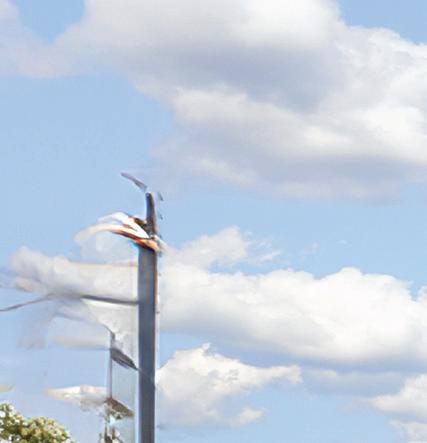


























By Patrick Langston
It may be the world’s only carport renovation inspired by a bird in flight.
The project by Ottawa’s 25:8 Architecture + Urban Design is more than just a carport. The startlingly delightful wood-clad addition to a standard-issue 1970s brick duplex in the Westboro Beach neighbourhood also serves as a rooftop deck for observing birds on the surrounding National Capital Commission land and houses both a new home office and a family living area.
The project, dubbed #Ferndale_ Flightdeck, won trophies for both exterior design details and home renovation at Ottawa’s 2023 Housing Design Awards and was a finalist for the All Things
Home People’s Choice Award.

That it wound up resembling a soaring bird, with the wood cladding extending to the ground like a wing, was accidental, according to Jay S. Lim, lead designer on the project and founder of 25:8.
The homeowners wanted to renovate their aging carport and add indoor family space. “We found out they were bird watchers almost in passing. When we went to their house, we saw all these birds and some binoculars and said, ‘Oh, that’s interesting.’ And they said, ‘Yeah, it would be great if the new office could see out to the birds.’ That initiated the design.”
The 25:8 team started batting ideas around and one morning Lim woke up and began doodling with thoughts of flying birds in mind. “I started thinking, ‘Could we make this thing look lighter and hide the structure behind it?’” He soon came up with the wing concept, which masks both a heavy structural “V” column that extends up from the
ground and a paddleboard storage area inside the new carport.
“Form followed function,” says Lim, paraphrasing American modernist architect Louis Sullivan’s famous maxim.
The resulting form is a structure that appears to hover above the ground, an illusion encouraged by the upward movement of the pine cladding and the graceful curves of the design.
The elegant addition also provides privacy for the second-storey deck, acts as a guardrail to protect people using the new outdoor space and includes apertures cut from the façade — the one near the front resembles a bird’s eye — that create framed views of the surrounding, well-treed land and a discrete viewing platform for the avid birdwatchers.
The addition’s front façade with its white cement board has a single window from which the homeowners can see more trees. When the young family plays basketball in the driveway, a sliding battened screen protects the window.
The addition is unusual, but that was fine with the clients, says Lim. “When they understood why it looked like it did, they were all for it. The design does a lot of things they never thought they wanted, (but) they were open (to it).”
The structure is also simple. “There’s elegance in simplicity,” Lim says. “There is a trend in the city that sees extraneous material put on and a lot of detail at a lot of cost. (Our design) allows you to focus on the form, reduces the cost and refines the palette.”
Inside the addition, 25:8 added a rear-facing office and a multi-purpose family space with access to the deck. The new, airtight interior space is heated and cooled by an air-source heat pump hidden behind the pine

Top: The award-winning project by 25:8 Architecture + Urban Design was inspired by the homeowners’ love of birdwatching.
Right: The aperture in the upper part of the façade allows birdwatching from the observation deck or though the family room window.
ALL PHOTOS BY BRENDAN BURDEN
façade below. In the existing home, 25:8 also designed a new bathroom adjacent to the addition.
The flightdeck project responds to its natural environment and serves as a transition from the street’s regimented row of homes to the wooded area around it, including a trailhead to the National Capital Commission land.
Lim imagines it becoming a neighbourhood landmark, with hikers saying, “’Okay, let’s meet by the flightdeck.”


PatrickLangstonistheco-founderofAllThings HomeInc.,wheredetailsonhowtodomostof theabovetaskscanbefound(allthingshome.ca). TheveteranjournalisthascoveredtheOttawa housingindustrysince2008.










































































